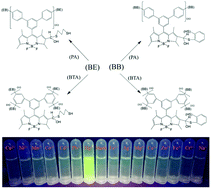Bodipy-based chemosensors for highly sensitive and selective detection of Hg2+ ions†
Abstract
Detection of heavy metals with high sensitivity and selectivity is of vital importance. In this study, we report the synthesis of small molecular chemosensors and the fabrication of corresponding macromolecular fluorescent chemosensors. Boron dipyrrole methane (BODIPY)-derived chemosensors, BE and BB, were designed and synthesized first. Then, they were incorporated into polymeric derivatives to prepare macromolecular fluorescent chemosensors. The small molecular sensors were highly sensitive and selective to Hg2+. Other ions and albumin did not exhibit clear interference to the sensing of Hg2+ ions. Once the macromolecular chemosensors were formed, the recognition ability was preserved; moreover, the sensitivity was even enhanced by the “molecular wire” mechanism. The minimum detection limits of four macromolecular chemosensors, PBEP, PBEB, PBBP and PBBB, for Hg2+ reached 2.05 μM, 0.23 μM, 4.23 μM, and 0.15 μM, respectively. Under natural light, the addition of Hg2+ led to significant color changes; also, they can be used as Hg2+-sensitive “naked eye” indicators in the natural environment.



 Please wait while we load your content...
Please wait while we load your content...